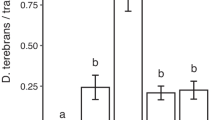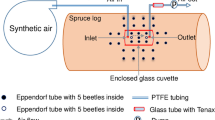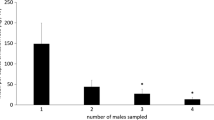Abstract
Release of the antiaggregation pheromone, verbenone, at 3.8 mg/ day from a concentrated source within a multiple-funnel trap completely inhibited response by the mountain pine beetle (MPB),Dendroctonus ponderosae Hopkins, to attractive semiochemical lures. When aerial applications were simulated and verbenone was released at the same rate from beads lying in a 2×2-m area on the forest floor 15–35 cm below a trap, the response of the MPB was inhibited by only 50%. This reduced inhibition may be explained in part by the photoisomerism of verbenone. When exposed to full sunlight on two occasions, the times required for 50% of verbenone vapors to be converted to chrysanthenone were 75 and 100 min, respectively. Trap and tree-baiting experiments indicated no biological activity of chrysanthenone. Rapid photoisomerization could reduce the concentration of verbenone below biologically active levels and would allow the MPB to colonize trees close to already occupied hosts, contributing to the characteristic clumped distribution of MPB attack. The rate of verbenone photoisomerization may vary according to geographic location, stand elevation and density, and should be considered before verbenone is applied to control the MPB and other bark beetles.
Similar content being viewed by others
References
Amman, G.D., Thier, R.W., McGregor, M.D., andSchmitz, R.F. 1989. Efficacy of verbenone in reducing lodgepole pine infestations by mountain pine beetles in Idaho.Can. J. For. Res. 19:60–64.
Amman, G.D.,Their, R.W.,Weatherby, J.C.,Rasmussen, L.A., andMunson, A.S. 1991. Optimum dosage of verbenone to reduce infestation of mountain pine beetle in lodgepole pine stands of central Idaho. USDA, Forest Service, Res. Pap. INT-446.
Aylor, D.E. 1976. Estimating peak concentration of pheromones in the forest, pp. 177–188,in J.F. Anderson, and H.K. Kaya, (eds.). Perspectives in Forest Entomology. Academic Press, New York.
Billings, R.F., andGara, R.I. 1975. Rhythmic emergence ofDendroctonus ponderosae (Coleoptera: Scolytidae) from two host species.Ann. Entomol. Soc. Am. 68:1033–1036.
Borden, J.H., andLindgren, B.S. 1988. The role of semiochemicals in IPM of the mountain pine beetle, pp. 247–255,in T.L. Payne, and H. Saarenma (eds.). Integrated Control of Scolytid Bark Beetles. Virginia Polytechnic Institute and State University, Blacksburg, Virginia.
Borden, J.H., Ryker, L.C., Chong, L.J., Pierce, H.D., Jr., Johnston, B.D., andOehlschlager, A.C. 1987. Response of mountain pine beetleDendroctonus ponderosae Hopkins (Coleoptera: Scolytidae) to five semiochemicals in British Columbia lodgepole pine forests.Can. J. For. Res. 17:118–128.
Conn, J.E., Borden, J.H., Scott, B.E., Friskie, L.M., Pierce, H.D., Jr., andOehlschlager, A.C. 1983. Semiochemicals for the mountain pine beetle,Dendroctonus ponderosae, in British Columbia: Field trapping studies.Can. J. For. Res. 13:320–324.
Conover, W.J. 1980. Practical Nonparametric Statistics. Wiley, New York.
Erman, W.F. 1967. Photochemical transformations of unsaturated bicyclic ketones. Verbenone and its photodynamic products of ultraviolet irradiation.J. Am. Chem. Soc. 89:3828–3841.
Fares, Y., Sharpe, P.J.H., andMagnuson, C.E. 1980. Pheromone dispersion in forests.J. Theor. Biol. 84:335–339.
Friedman, M. 1937. The use of ranks to avoid the assumptions of normality implicit in the analysis of variance.J. Am. Stat. Assoc. 32:675–701.
Gibson, K.E.,Schmitz, R.F.,Amman, G.D., andOakes, R.D. 1991. Mountain pine beetle response to different dosages of verbenone in pine stands of western Montana. USDA, Forest Service, Res. Pap. INT-444.
Geiszler, D.R., andGara, R.I. 1978. Mountain pine beetle attack dynamics in lodgepole pine, pp. 182–187,in A.A. Berryman, G.D. Amman, and R.W. Stark (eds.). Theory and Practice of Mountain Pine Beetle Management in Lodgepole Pine Forests. University of Idaho, Moscow, and USDA, Forest Service, Washington, D.C.
Geiszler, D.R., Gallucci, V.F., andGara, R.I. 1980. Modelling the dynamics of mountain pine beetle aggregation in a lodgepole pine stand.Oecologia 46:244–253.
Hunt, D.W.A., andBorden, J.H. 1989. Terpene alcohol pheromone production byDendroctonus ponderosae andIps paraconfusus (Coleoptera: Scolytidae) in the absence of readily culturable microorganisms.J, Chem. Ecol. 15:1433–1463.
Hunt, D.W.A., andBorden, J.H. 1990. Conversion of verbenols to verbenone by yeasts isolated fromDendroctonus ponderosae (Coleoptera: Scolytidae).J. Chem. Ecol. 16:1385–1397.
Hunt, D.W.A., Borden, J.H., Lindgren, B.S., andGries, G. 1989. The role of autoxidation ofα-pinene in the production of pheromones ofDendroctonus ponderosae (Coleoptera: Scolytidae).Can. J. For. Res. 19:1275–1282.
Klein, W.H. 1978. Strategies and tactics for reducing losses in lodgepole pine to the mountain pine beetle by chemical and mechanical means, pp. 148–158,in A.A. Berryman, G.D. Amman, and R.W. Stark, (eds.). Theory and Practice of Mountain Pine Beetle Management in Lodgepole Pine Forests. University of Idaho, Moscow, and USDA, Forest Service, Washington, D.C.
Koller, L.R. 1965. Ultraviolet Radiation, 2nd Ed., Wiley, New York.
Kostyk, B.C. 1992. The efficacy and photodecomposition of verbenone: A repellent semiochemical of the mountain pine beetle,Dendroctonus ponderosae. Master of pest management thesis, Simon Fraser University, Burnaby, British Columbia.
Lindgren, B.S., Borden, J.H., Cushon, G.H., Chong, L.J., andHiggins, C.J. 1989. Reduction of mountain pine beetle (Coleoptera: Scolytidae) attacks by verbenone in lodgepole pine stands in British Columbia.Can. J. For. Res. 19:65–68.
Lyon, R.L. 1958. A useful secondary sex characteristic inDendroctonus bark beetles.Can. Entomol. 60:582–584.
McCambridge, W. 1971. Temperature limits of the flight of mountain pine beetle,Dendroctonus ponderosae.Ann. Entomol. Soc. Am. 64:534–535.
Mitchell, R.G., andPriesler, H.K. 1991. Analysis of spatial patterns of lodgepole pine attacked by outbreak populations of the mountain pine beetle.For. Sci. 37:1390–1408.
Peterman, R. 1978. The ecological role of the mountain pine beetle in lodgepole pine forests, pp. 16–21,in A.A. Berryman, G.D. Amman and R.W. Stark (eds.). Theory and Practice of Mountain Pine Beetle Management in Lodgepole Pine Forests. University of Idaho, Moscow, and USDA, Forest Service, Washington, D.C.
Pitman, G.B., Vité, J.P., Kinzer, G.W., andFentiman, A.F., Jr. 1969. Specificity of population-aggregating pheromones inDendroctonus.J. Insect Physiol. 15:363–366.
Raffa, K.F., andBerryman, A.A. 1983. The role of host plant resistance in the colonization behavior and ecology of bark beetles (Coleoptera: Scolytidae).Ecol. Monogr. 53:27–49.
Renwick, J.A., andVité, J.P. 1970. Systems of chemical communication inDendroctonus.Contrib. Boyce Thompson Inst. Plant Res. 24:283–292.
Rudinsky, J.A., Morgan, M.E., Libbey, L.M., andPutnam, T.B. 1974. Antiaggregative-rivalry pheromone of the mountain pine beetle and a new arrestant of the southern pine beetle.Environ. Entomol. 3:90–98.
Ryker, L.C., andYandell, K.L. 1983. Effect of verbenone on aggregation ofDendroctonus ponderosae Hopkins (Coleoptera: Scolytidae) to synthetic attractant.Z. Angew. Entomol. 96:452–459.
Safranyik, L. 1978. Effects of climate and weather on mountain pine beetle populations, pp. 77–86,in A.A. Berryman, G.D. Amman, and R.W. Stark (eds.). Theory and Practice of Mountain Pine Beetle Management in Lodgepole Pine Forests. University of Idaho, Moscow, and USDA, Forest Service, Washington, D.C.
Safranyik, L., Shrimpton, D.M., andWhitney, H.S. 1974. Management of lodgepole pine reduces losses from the mountain pine beetle. For. Tech. Rep. No. 1. Environ. Canada, Pac. For. Res. Cent., Victoria, British Columbia.
SASInstitute. 1985. User's Guide. SAS Institute, Inc., Cary, North Carolina.
Shea, P.J., McGregor, M.D., andDaterman, G.E. 1992. Aerial application of verbenone beads reduces lodgepole pine mortality by mountain pine beetle.Can. J. For. Res. 22:436–441.
Author information
Authors and Affiliations
Rights and permissions
About this article
Cite this article
Kostyk, B.C., Borden, J.H. & Gries, G. Photoisomerization of antiaggregation pheromone verbenone: Biological and practical implications with respect to the mountain pine beetle,Dendroctonus ponderosae Hopkins (Coleoptera: Scolytidae). J Chem Ecol 19, 1749–1759 (1993). https://doi.org/10.1007/BF00982305
Accepted:
Issue Date:
DOI: https://doi.org/10.1007/BF00982305




